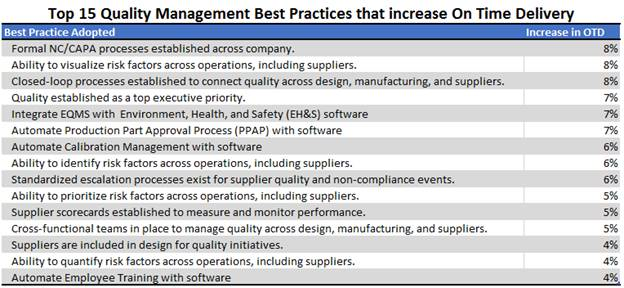On Wednesday, January 11, LNS Research hosted the webcast, “Supercharge Supplier Quality Management (SQM) for Competitive Advantage.” The presentation explained what today’s quality leaders must do to realize the full value of quality efforts, particularly in light of rapidly changing market and regulatory conditions.
Q: Is this just for big companies? What about small and mid-size companies?
A: SQM is an ISO requirement for ISO-certified companies of all sizes. That said, SQM for compliance is quite different than SQM for differentiation. The research and guidance applies to companies of all sizes as well; particularly those with complex supply chains or substantially supplied content.
In fact, the research shows that companies that are OEMs or Tier 1's have much higher percentage adoption of SQM, which can provide them increased oversight into their suppliers’ performance. This can create a business challenge for suppliers that lack adequate visibility into their own supply chains.
Q: You mentioned On Time Delivery and SQM. How do these relate?
A: Effective SQM reduces disruptions in manufacturing operations. The chart below shows the top 15 quality management best practices that have resulted in increased On Time Delivery. The analysis compares the On Time Delivery of those that adopted the practice to those that did not. As can be seen, 10 of the top 15 best practices include suppliers. 
Q3: How long have you seen it take to get to a mature state in SQM?
A3: This depends upon the As Is maturity of the company. This is a process that often takes years because it is truly a journey. It’s important to follow the steps outlined by the research and to demonstrate value to your stakeholders as you deploy and improve. SQM is mutually beneficial, but it is valuable to demonstrate that through improvements over time.
Q4: What holds companies back from reaching higher maturity levels?
A4: One common challenge is the culture of quality that is needed for deploying cross-functional teams, processes and technology are slow to build. It is quicker to build this top down. Related to this challenge is the perceived value of SQM investment by executives. The research has been communicating this over the past year, but it is important to continue to reinforce value by developing hard ROI where possible, particularly value for other stakeholders. Depending upon the culture, efficiency gains are often seen as less compelling than an improvement on core KPIs such as On Time Delivery.
Q5: You said SQM could be used to understand supplier risk and risk associated with their products. How does this work in practice?
A5: Practically, this should be a part of a supplier scorecard. Often companies have different methods to categorize supplier risk, but there should be an accepted risk framework, and then the supplier’s risk should be calculated against that framework including inputs such as number of Supplier Corrective Action Reports (SCARs), number of Non-Conformances (NC), Audit Findings, Waivers, etc. More detailed risk can be performed if the appropriate capabilities exist, for instance looking at risk of a given supplier to successfully deliver a given part. The supplier’s risk can often result in different approaches to working with the supplier. As an example, a low-risk supplier may have lower audit requirements.
Q6: Do you have any clients that focus on this topic?
A6: Absolutely. Our Global Executive Council requested that this be the topic of the next executive roundtable – it’s a high priority.
The webcast recording and slides will be available and distributed on Wednesday, January 18.
